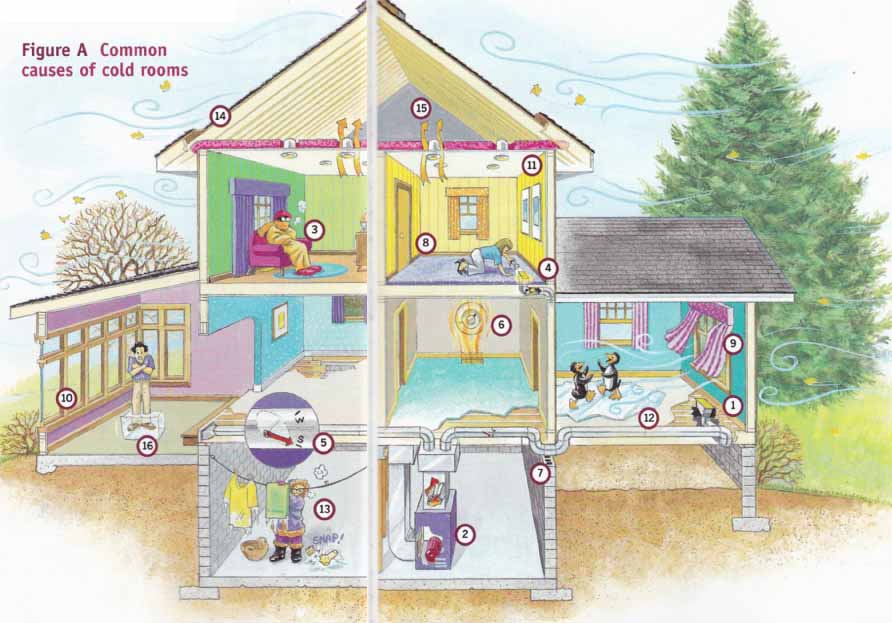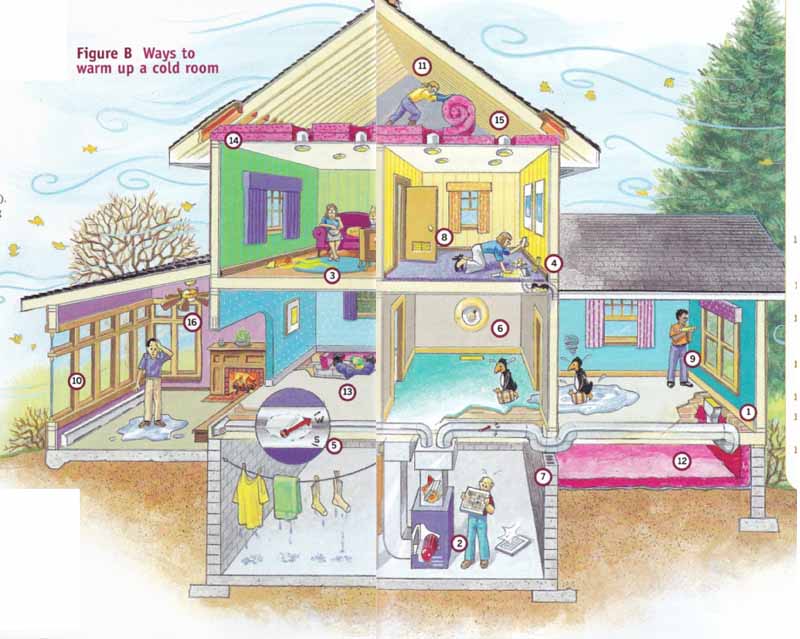|
Just as tuning up your car will help you save at the gas pump tuning up your furnace or boiler and fireplace before winter will help you save on your monthly utility bill. Some tasks—like tuning up your furnace or boiler—can be complex enough to require professional help. But there are simple steps anyone can take Just replacing the dirty filter on your forced air furnace can reduce your gas or electric bill by 10 percent. Sealing up leaky air ducts can reduce it by another 10 percent and installing (and actually using) a $50 setback thermostat can save you hundreds of dollars over the course of a winter
Don’t overlook the obvious Make sure the glass panels of your storm windows and storm doors are shut tight . Keep south facing shades open during the day to harvest free solar heat Make sure your fireplace damper is closed when not in use and when it does come time to replace that old 60 percent efficient furnace or boiler look into one of the high-efficiency units available some of the newer ENERGY STAR qualified furnaces and boilers are 90 percent or more efficient.
Warm up a cold room: 16 common problems and 16 (sometimes) simple solutions
Bugged by a chilly room in the winter? If you have to wear an extra pair of heavy socks in the family room or huddle under the covers at night, you’re not alone.
A chilly room is as common as, well, a common cold.
It’s not always easy or cheap, but there’s always a way to chase those chills. Here you’ll find the causes (___ A) and the solutions (___ B). Plus, you’ll discover the least expensive options, what you can do yourself and when to call in a heating expert. The focus here is on homes with forced-air heating systems—that is, homes with blowers and ductwork. However, many of these solutions will work in homes heated by other systems.

___ B: Ways to warm up a cold room
Problems in the duct system
Obstructions. It may seem obvious, but you might have forgotten that you closed the register during the cooling season (1). Embarrassing! But more often the culprit is at the furnace in the form of a clogged filter or dirty air-conditioning coil that’s blocking the airflow (2). It’s easy to change the filter, but you can’t clean the coil yourself, and on many furnaces you can’t see it well enough to tell if it’s dirty. Rely on professional service every year or two to detect a dirty coil.
Sofas, desks and chairs as well as drapes can block the airflow at registers (3). Plastic deflectors or registers with different “throw” patterns aren’t always attractive, but they offer partial solutions. Or move the furniture; it’s simpler than moving the register.
Sometimes construction debris falls into the ducts, and the builders forget to fish it out (4). Unscrew the register and look down with a flash light, or reach into the duct with a gloved hand to retrieve anything you can feel. With any luck, it won’t have fur or feathers!
Energy-Saving Goof: Insulation inflation My husband I and bought a big bundle of insulation to insulate our shop. The huge bundle was actually five bundles wrapped together. I could barely lift it into the truck, so we decided to cut the bundle and load the individual bundles one at a time onto the truck bed. As soon as we cut it, it expanded to about four times its original size, much too large to fit into the truck. We had to buy some rope and spend a half hour wrestling the stuff into a manageable size. |

___ A: Common causes of cold rooms
PROBLEMS (numbers below correspond to numbers in figure above)
1. Closed register
2. Furnace filter or air- conditioning coil dirty and clogged
3. Drapes and furniture block heat flow
4. Clogged ducts
5. Dampers closed down
6. Thermostat located in a warm area
7. Duct has too many bends or is too small
8. No cool-air return
9. Drafty windows
10. Addition has many windows
11. Poor attic or wall insulation
12. Cold floor over crawlspace
13. Cold basement
14. No air chutes or poorly installed chutes
15. Heat loss due to leaks
16. Uninsulated floor
Badly balanced dampers. Every duct system is supposed to have dampers to balance the heat flow to each room (5). In fact, some systems require that you adjust the dampers twice a year, when you go from air-conditioning mode to the heating mode and back again. Look for the dampers near the main trunk lines. Contractors usually label the correct position. But not always. Open the damper farther for the duct serving the cold room. Unfortunately, dampers are often covered during remodeling, or hidden under insulation in the attic. You might have to call in a heating contractor to help out.
“Hot” thermostat. If the thermostat area heats up fast, it’ll shut off the furnace before other rooms warm up (6). Close nearby registers to lessen the warm airflow near the thermostat, and adjust the register louvers in other rooms to help balance the heat flow. A $3 room thermometer is handy for comparing temperatures from room to room.
Bad duct design. Design problems can include too many bends in a run (7) and inadequate cool-air returns (8). While ___ B suggests design solutions, be sure to consult a heating contractor for advice on the best methods and materials. But go through the rest of this list first. You might find a simpler, less expensive solution.
Bad windows
Leaky, inefficient windows are notorious heat drains, especially in older homes (9). Stop drafts with caulk and weatherstripping and add heavy drapes if necessary. Replacing worn-out windows with new, energy-efficient windows often solves the cold room problem.
But even good windows can’t always make up for the heat loss in a room with a lot of glass (10). For these rooms, you may have to consider additional ducts, or an additional heater with a separate thermo stat. Both are expensive and require the advice of a heating pro.
Quick TIP:By increasing the amount of humidity in your home during the colder seasons, you’ll feel warmer. Additional interior moisture can make a room set at 68 degrees F feel 5 to 8 degrees warmer.
Bad insulation
Finding out you have poor insulation is frustrating, because insulation was easy to install when your house was built but it’s difficult and expensive to add it now (11). Attic insulation is an exception. If your attic has 6 in. or less, add at least another 6 in. of fiber glass or cellulose to warm up cold rooms directly below. Other exceptions include crawlspace or floor insulation for cold floors over a crawlspace (12), and rim joist insulation for basements (13).
While you’re up in your attic, make sure you have vent chutes and that they’re properly positioned (14). Cold air blowing through the insulation can chill the ceiling of the room below.
Insulation installers often fail to close up ceiling gaps, and warm air leaks out (15). Seal areas around light fixtures, plumbing pipes, ducts and other gaps into attics with caulk or expanding foam. Usually you can reach these only from the attic.
Bad Mixing and Cold Slabs
Without good mixing, warm air rises and cool air falls, chilling your feet, especially in rooms with tall ceilings and on uninsulated concrete floors (16). If the airflow from the registers doesn’t do the job, slow-moving ceiling fans can get the warm air down to the floor where you need it.
SOLUTIONS (numbers below correspond to numbers in figure above)
- Open the register.
- Change furnace filter and check for dirty air-conditioning coil with flashlight; call a pro to clean the coil.
- Add plastic deflector ($5 at home centers or heating-supply dealers) and rearrange furniture.
- Clean out debris as far as you can reach.
- Adjust dampers for higher airflow.
- Close registers around thermostat; use thermometer to compare room temperatures.
- Install larger ducts where possible; add more runs if possible.
- Undercut door 3/4 in. or add louvers; adding new return ducts is difficult.
- Caulk and weather-strip windows or replace with tighter, higher- efficiency units.
- Increase heat flow if possible; add supplemental heat (gas fireplace, electric).
- Increase attic and wall insulation if possible.
- Insulate floor if crawlspace is vented, or insulate crawlspace perimeter and ground if closed off.
- Insulate rim joists and basement; add more registers in basement.
- Install attic vent chutes.
- Seal leaks to attic at plumbing stacks, around lights and chimneys.
- Increase heat flow, add supplemental heat or encourage better mixing with ceiling fan.
Next: Programmable Thermostat
Prev: Sealing attic air leaks